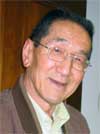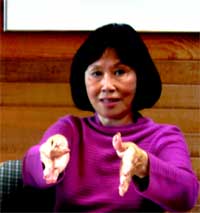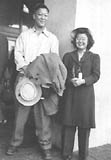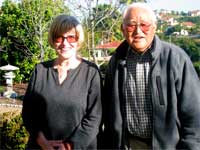
Sixty years have passed. How did you manage to find the children who wrote to Miss Breed ? When I started, I was not sure if any or many of the correspondents were still alive. Thanks to the internet I was able to communicate with curators at the Japanese American National Museum. Since I was initially too ill to come to California, Snowden Becker, then the online archivist who loved Miss Breed, as I did, sent me an electronic file of all the letters.
It was Babe who sent me to the late Don Estes, an historian and person he called the "greatest Nisei in San Diego." Thanks to Babe and Don I met Elizabeth Kikuchi Yamada who helped me connect with so many others. I suppose it all could have happened by mail and phone, but the internet did help a lot! I obtained the childhood photo of Clara with her sister and mother after I found a reference to an uncle in Stockton who, during the war, also helped with the evacuation of the Nikkei community. An e-mail to his church led me to their present minister, who in led me to Clara's cousins, whom I did not know existed. Their interviews gave me still more stories of Clara.
I suppose the short answer is that finding those who could tell the story was like playing detective--an adventure with exciting leads found on microfilm, through conversations, and the letters. I have never met more generous people, who have shared the story so that it will not be forgotten! Perhaps the greatest surprise came just as we were about the send the book to press. It was discovered so late that we had to put it on the last page of the book, after the index. It is a letter that has been tucked away for more than 60 years-a letter from Clara herself, the only letter to one of the correspondents that is known to exist! Do the correspondents you interviewed feel differently about their incarceration than they did in their letters? Memories of those years are colored by how old they were at the time. Most of those who were still in school say that they made the most of their junior and senior high school lives, making friendships that have lasted for more than 60 years. For those who were on the brink of life, ready for college or work, the incarceration was more of a bitter memory. Many were deeply hurt and offended for their parents who lost most of what they had worked so hard to secure. With few exceptions, the letters to Miss Breed seem to filter out the unpleasant nature of their lives in the horse stables of Santa Anita or the brutal desert of roastem' toastem' Poston, Arizona. Determined to show their patriotism, they found positive ways to write about their lives. But in their recent interviews, their adult stories give a fuller and a less sanitized story than their letters they sent to Miss Breed. While many felt they were being patriotic by going along in 1942, many said they would never go so willingly today!
|
 |
 |
 |
 |
 |
 |
 |
 |
 She also put me in touch with "Babe" Karasawa, a docent at the museum who had gathered permission for the use of the letters and spoken with all the correspondents who were still alive.
She also put me in touch with "Babe" Karasawa, a docent at the museum who had gathered permission for the use of the letters and spoken with all the correspondents who were still alive.
 Thanks to the help of so many, I was able to interview all of the surviving correspondents. Fusa Tsumagari and Katherine Tasaki had died, but I was able to interview Fusa'a daughter Patty and her friend Chiyo as well as Ben Segawa, Katherine's husband.
Thanks to the help of so many, I was able to interview all of the surviving correspondents. Fusa Tsumagari and Katherine Tasaki had died, but I was able to interview Fusa'a daughter Patty and her friend Chiyo as well as Ben Segawa, Katherine's husband. 
